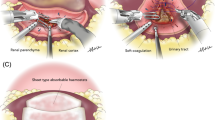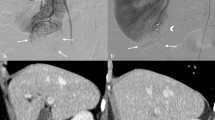Key Points
-
Warm ischaemia time (WIT) is seemingly the sole variable that surgeons strive to address in minimizing loss of renal function after partial nephrectomy
-
The term 'zero ischaemia' partial nephrectomy has been inconsistently, if not arbitrarily, applied by researchers and surgeons alike
-
The development of various novel partial nephrectomy techniques has been accompanied by even more substantial diversity in the methods of reporting postoperative renal functional outcomes
-
The diversity in the methods of reporting functional outcomes stems from the lack of evidence to support the adoption of a particular parameter for measurement of postoperative renal functional outcomes
-
The absence of a consensus on the measurement of postoperative functional outcomes hampers the effective evaluation of the various novel techniques that aim to reduce WIT in nephron-sparing surgery
-
An unmet need exists to establish standard and reproducible classifications or guidelines to accurately describe technical terms and quantify renal functional outcome to match the continuously evolving field of nephron-sparing surgery
Abstract
Nephron-sparing surgery for the removal of small renal masses delivers equivalent oncological outcomes and better functional outcomes compared with those associated with radical nephrectomy. All contemporary partial nephrectomy techniques including open, laparoscopic and robotic approaches involve the use of hilar clamping in order to facilitate haemostasis, and to enable accurate tumour excision and parenchymal reconstruction. Zero ischaemia was subsequently introduced as a technique to eliminate the renal ischaemia induced by hilar clamping. Following the introduction of zero ischaemia techniques, researchers have arbitrarily applied this term to techniques ranging from no use of clamping to selective clamping of renal arteries and/or veins, or their branches. Substantial variations exist in the way that zero ischaemia and other renal preservation techniques are described in the literature. Similarly, further diversity exists in the measurement and reporting of functional outcomes after surgery. The introduction of standard and reproducible classifications or guidelines will ensure consistency and uniformity. Establishing consensus on the terminology used to describe techniques and functional outcomes will not only facilitate improved communication and surgical practice, but will also enable critical appraisal of surgical techniques.
This is a preview of subscription content, access via your institution
Access options
Subscribe to this journal
Receive 12 print issues and online access
$209.00 per year
only $17.42 per issue
Buy this article
- Purchase on Springer Link
- Instant access to full article PDF
Prices may be subject to local taxes which are calculated during checkout


Similar content being viewed by others
References
Guideline for management of the clinical stage 1 renal mass, https://www.auanet.org/common/pdf/education/clinical-guidance/Renal-Mass.pdf (American Urological Association Education and Research, Inc., 2009).
Jordan, G. H. & Winslow, B. H. Laparoendoscopic upper pole partial nephrectomy with ureterectomy. J. Urol. 150, 940–943 (1993).
Winfield, H. N., Donovan, J. F., Godet, A. S. & Clayman, R. V. Laparoscopic partial nephrectomy: initial case report for benign disease. J. Endourol. 7, 521–526 (1993).
Leslie, S., Goh, A. & Gill, I. Partial nephrectomy—contemporary indications, techniques and outcomes. Nat. Rev. Urol. 10, 275–283 (2013).
Ficarra, V., Rossanese, M., Gnech, M., Novara, G. & Mottrie, A. Outcomes and limitations of laparoscopic and robotic partial nephrectomy. Curr. Opin. Urol. 24, 441–447 (2014).
Nguyen, M. & Gill, I. Halving ischemia time during laparoscopic partial nephrectomy. J. Urol. 179, 627–632 (2008).
Simmons, M. N., Fergany, A. F. & Campbell, S. C. Effect of parenchymal volume preservation on kidney function after partial nephrectomy. J. Urol. 186, 405–410 (2011).
Thompson, R. H. et al. Renal function after partial nephrectomy: effect of warm ischemia relative to quantity and quality of preserved kidney. Urology 79, 356–360 (2012).
Gill, I. S. et al. “Zero ischemia” partial nephrectomy: novel laparoscopic and robotic technique. Eur. Urol. 59, 128–134 (2011).
Thompson, R. et al. Every minute counts when the renal hilum is clamped during partial nephrectomy. Eur. Urol. 58, 340–345 (2010).
Zargar, H. et al. The impact of extended warm ischemia time on late renal function after robotic partial nephrectomy. J. Endourol. 29, 444–448 (2015).
Lane, B. R., Gill, I. S., Fergany, A. F., Larson, B. T. & Campbell, S. C. Limited warm ischemia during elective partial nephrectomy has only a marginal impact on renal functional outcomes. J. Urol. 185, 1598–1603 (2011).
Porpiglia, F. et al. Evaluation of functional outcomes after laparoscopic partial nephrectomy using renal scintigraphy: clamped versus clampless technique. BJU Int. 115, 606–612 (2015).
Wiener, S. et al. Predictors of postoperative decline in estimated glomerular filtration rate in patients undergoing robotic partial nephrectomy. J. Endourol. 28, 807–813 (2014).
Abreu, A., Gill, I. & Desai, M. Zero-ischaemia robotic partial nephrectomy (RPN) for hilar tumours. BJU Int. 108, 948–954 (2011).
Gill, I. S. et al. Zero ischemia anatomical partial nephrectomy: a novel approach. J. Urol. 187, 807–815 (2012).
Satkunasivam, R. et al. Robotic unclamped “minimal-margin” partial nephrectomy: ongoing refinement of the anatomic zero-ischemia concept. Eur. Urol. 68, 705–712 (2015).
Shin, T. et al. Simplified zero ischemia in robot assisted partial nephrectomy: initial yonsei experience. Korean J. Urol. 54, 78–84 (2013).
Papalia, R. et al. Laparoscopic and robotic partial nephrectomy without renal ischaemia for tumours larger than 4 cm: perioperative and functional outcomes. World J. Urol. 30, 671–676 (2012).
Ng, C. et al. Anatomic renal artery branch microdissection to facilitate zero-ischemia partial nephrectomy. Eur. Urol. 61, 67–74 (2012).
Peña, J. et al. The road to real zero ischemia for partial nephrectomy. J. Endourol. 27, 936–942 (2013).
Rizkala, E. et al. Zero ischemia robotic partial nephrectomy: sequential preplaced suture renorrhaphy technique. Urology 82, 100–104 (2013).
D'Urso, L. et al. Benefits and shortcomings of superselective transarterial embolization of renal tumors before zero ischemia laparoscopic partial nephrectomy. Eur. J. Surg. Oncol. 40, 1731–1737 (2014).
Imkamp, F. et al. Initial experiences with the Hemopatch® as a hemostatic agent in zero-ischemia partial nephrectomy. World J. Urol. 33, 1527–1534 (2014).
Engel, J. D. & Williams, S. B. Unclamped hand-assisted laparoscopic partial nephrectomy for predominantly endophytic renal tumors. Urol. J. 10, 767–773 (2013).
Simone, G., Papalia, R., Guaglianone, S., Carpanese, L. & Gallucci, M. Zero ischemia laparoscopic partial nephrectomy after superselective transarterial tumor embolization for tumors with moderate nephrometry score: long-term results of a single-center experience. J. Endourol. 25, 1443–1446 (2011).
Simone, G., Papalia, R., Guaglianone, S. & Gallucci, M. ''Zero ischaemia'' sutureless laparoscopic partial nephrectomy for renal tumours with a low nephrometry score. BJU Int. 110, 124–130 (2011).
Liu, W. et al. Off-clamp versus complete hilar control partial nephrectomy for renal cell carcinoma: a systematic review and meta-analysis. J. Endourol. 28, 567–576 (2014).
Smith, G. L., Kenney, P. A., Lee, Y. & Libertino, J. A. Non-clamped partial nephrectomy: techniques and surgical outcomes. BJU Int. 107, 1054–1058 (2011).
Kopp, R. P. et al. Factors affecting renal function after open partial nephrectomy—a comparison of clampless and clamped warm ischemic technique. Urology 80, 865–870 (2012).
Papalia, R. et al. Laparoscopic and robotic partial nephrectomy with controlled hypotensive anesthesia to avoid hilar clamping: feasibility, safety and perioperative functional outcomes. J. Urol. 187, 1190–1194 (2012).
Kim, T. S., Oh, J. H. & Rhew, H. Y. ''Off-clamp, non-renorrhaphy'' laparoscopic partial nephrectomy with perirenal fat and Gerota's fascia reapproximation: initial experience and perioperative outcomes. J. Laparoendosc. Adv. Surg. Tech. A 24, 339–344 (2014).
Rais-Bahrami, S. et al. Off-clamp versus complete hilar control laparoscopic partial nephrectomy: comparison by clinical stage. BJU Int. 109, 1376–1381 (2011).
George, A. K. et al. Perioperative outcomes of off-clamp versus complete hilar control laparoscopic partial nephrectomy. BJU Int. 111, E235–E241 (2013).
Springer, C. et al. Clampless laparoendoscopic single-site partial nephrectomy for renal cancer with low PADUA score: technique and surgical outcomes. BJU Int. 111, 1091–1098 (2013).
Salami, S. S. et al. Off-clamp laparoscopic partial nephrectomy for hilar tumors: oncologic and renal functional outcomes. J. Endourol. 28, 191–195 (2014).
Kaczmarek, B. F. et al. Off-clamp robot-assisted partial nephrectomy preserves renal function: a multi-institutional propensity score analysis. Eur. Urol. 64, 988–993 (2013).
Peyronnet, B. et al. Early unclamping technique during robotic partial nephrectomy can minimize warm ischemia without increasing morbidity. BJU Int. 114, 741–747 (2014).
Imbeault, A., Pouliot, F. & Dujardin, T. Prospective study comparing two techniques of clamping in laparosocpic partial nephrectomy: impact on perioperative parameters. J. Urol. 181, 473–474 (2009).
Simone, G., Papalia, R., Guaglianone, S., Forestiere, E. & Gallucci, M. Preoperative superselective transarterial embolization in laparoscopic partial nephrectomy: technique, oncologic, and functional outcomes. J. Endourol. 23, 1473–1478 (2009).
Shao, P. et al. Precise segmental renal artery clamping under the guidance of dual-source computed tomography angiography during laparoscopic partial nephrectomy. Eur. Urol. 62, 1001–1008 (2012).
Shao, P. et al. Laparoscopic partial nephrectomy with segmental renal artery clamping: technique and clinical outcomes. Eur. Urol. 59, 849–855 (2011).
McClintock, T. R. et al. Can selective arterial clamping with fluorescence imaging preserve kidney function during robotic partial nephrectomy? Urology 84, 327–332 (2014).
Simon, J. et al. Laparoscopic partial nephrectomy with selective control of the renal parenchyma: initial experience with a novel laparoscopic clamp. BJU Int. 103, 805–808 (2009).
Viprakasit, D. P. et al. Selective renal parenchymal clamping in robot-assisted laparoscopic partial nephrectomy: a multi-institutional experience. J. Endourol. 25, 1487–1491 (2011).
Simone, G. et al. Indications, techniques, outcomes, and limitations for minimally ischemic and off-clamp partial nephrectomy: a systematic review of the literature. Eur. Urol. 68, 632–640 (2015).
Hew, M. N. et al. Critical appraisal of the PADUA classification and assessment of the R.E.N.A.L. nephrometry score in patients undergoing partial nephrectomy. J. Urol. 186, 42–46 (2011).
Waldert, M. et al. External validation of the preoperative anatomical classification for prediction of complications related to nephron-sparing surgery. World J. Urol. 28, 531–535 (2010).
Mottrie, A. et al. Validation of the preoperative aspects and dimensions used for an anatomical (PADUA) score in a robot-assisted partial nephrectomy series. World J. Urol. 31, 799–804 (2013).
Wen, K. et al. Application of a standardized anatomical classification in a Chinese partial nephrectomy series. Int. J. Urol. 19, 551–558 (2012).
Papalia, R. et al. Novel kidney segmentation system to describe tumour location for nephron-sparing surgery. World J. Urol. 33, 865–871 (2015).
Levey, A. S. et al. A new equation to estimate glomerular filtration rate. Ann. Intern. Med. 150, 604–612 (2009).
Hougardy, J. M., Delanaye, P., Le Moine, A. & Nortier, J. [Estimation of the glomerular filtration rate in 2014 by tests and equations: strengths and weaknesses]. Rev. Med. Brux. 35, 250–257 (in French) (2014).
Tachikake, T. et al. Decrease of renal function due to warm ischemia after laparoscopic partial nephrectomy: evaluation using 99mTc-DMSA renal scintigraphy. Urol. Int. 82, 162–165 (2009).
Sankin, A. et al. Assessing renal function following partial neprectomy using renal nuclear scintigraphy and eGFR. Urology 80, 343–346 (2012).
Thomas, A. A. et al. Acute kidney injury: novel biomarkers and potential utility for patient care in urology. Urology 77, 5–11 (2011).
http://web.squ.edu.om/medLib/MED_CD/E_CDs/anesthesia/site/content/v02/020586r00.htm
Author information
Authors and Affiliations
Contributions
A.A. researched data for this article, A.A., A.M., and O.K. made a substantial contribution to discussions of content, A.A. wrote the manuscript and all authors edited and/or reviewed the manuscript before submission.
Corresponding author
Ethics declarations
Competing interests
The authors declare no competing financial interests.
PowerPoint slides
Rights and permissions
About this article
Cite this article
Alenezi, A., Novara, G., Mottrie, A. et al. Zero ischaemia partial nephrectomy: a call for standardized nomenclature and functional outcomes. Nat Rev Urol 13, 674–683 (2016). https://doi.org/10.1038/nrurol.2016.185
Published:
Issue Date:
DOI: https://doi.org/10.1038/nrurol.2016.185



